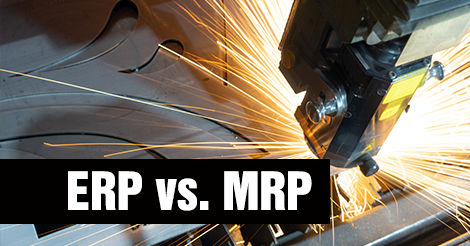The biggest difference between ERP vs MRP is that MRP software is designed specifically to manage inventory and manufacturing processes, whereas ERP software is designed for managing all aspects of your business operation. MRP is best for manufacturing-type businesses, whereas ERP will work for wholesalers, distributors, retailers, eCommerce businesses and a variety of other industries. Both ERP and MRP are software systems for business management, but each one is designed to handle different processes and is best suited for different business types.
What is an ERP System?
ERP stands for Enterprise Resource Planning and is a business software solution designed to manage all aspects of a company’s operations along the supply chain. While ERP features will vary depending on the industry, the software acts as an all-in-one system, eliminating the need to have multiple, standalone solutions. ERP software automates operations such as supply chain management, accounting and finances, sales, order entry and processing and shipping. For example, ERP for a wholesale and distribution business will include functionality for accounting, finance, inventory management, warehouse management, purchase orders, sales orders, contact management, reporting and more. The main benefits of implementing an ERP solution include:
- Having one solution to manage all business operations. This means you don't need to worry about trying to integrate systems or deal with the cost of buying and supporting multiple solutions.
- Eliminate manual and duplicate data entry. Since all information flows between the different parts of the software, it eliminates the need to manually track data in spreadsheets, or across other systems.
- Automate processes. Because the system works across departments, you can easily automate processes such as sending customers A/R notices when their accounts reach a certain threshold.
- Robust reporting on all areas of the business. With ERP software, you're able to pull information from the different areas of the software to generate reports. For example, a report on Sales by Customer by Product.
What is an MRP System?
MRP stands for Material Requirements Planning and provides specific functionality to estimate quantities of raw materials and schedule their delivery and use in finished goods processing. MRP is a manufacturing solution with a focus on providing tools for determining what production materials are needed and when. MRP does not necessarily provide features for managing a company’s entire operations The main benefits of implementing an MRP solution are:
- Maintaining appropriate levels of inventory so that the right materials are available for production
- Scheduling the production of work to take raw materials to finished goods based on specific timeframes
- Tracking the production process to help reduce costs and increase productivity
Since the features of MRP software can be limited to manufacturing-type processes, there may be certain situations where a company requires both an ERP system and an MRP system – or, there are some large-scale ERP solutions with built-in MRP functionality.
ERP vs MRP: How do you determine which system is right for your business?
Before you start searching for software, it is important to determine if your company requires an MRP system, an ERP system or both. Many businesses that identify as manufacturing companies do not do any of the manufacturing in-house, and instead, act as more of a wholesale distribution business with manufacturing partners. Before you start looking for MRP software, consider the following questions:
- Do you deal with raw materials, work-in-progress items and finished goods?
- Do you need to track non-inventory items such as labour?
- Do you need to schedule production?
- Do you have multiple BOMs for the same product?
- Is the product you create “custom” each time?
- Do you need to track waste or yield?
If you answered yes to most of the questions above, you likely need a true MRP solution, if not, you may be able to benefit from an ERP solution that has “light-manufacturing” functionality. Some ERP systems will include light manufacturing functionality for kitting, assembly and managing a simple BOM. The need to create kits and assemble products is significantly different from turning raw materials into finished goods. With kitting and assembly functionality, you can create kits of items and track the associated labour to do so. This allows you to then sell and track items as part of a kit, or individually.
In some cases, your business may require MRP software and ERP software where the MRP acts as a subsystem of the ERP. This allows the MRP to transmit information about materials, scheduling and the production process to the ERP to then inform other business departments. Alternatively, some large-scale MRP solutions included ERP-type functionality.
In Summary: The main difference between ERP vs MRP, is that ERP systems manage and automate a variety of back-office operations, whereas MRP systems focus on material management and production.










